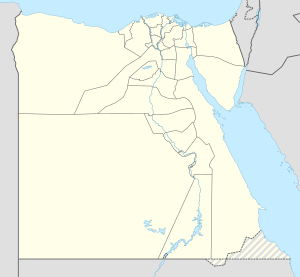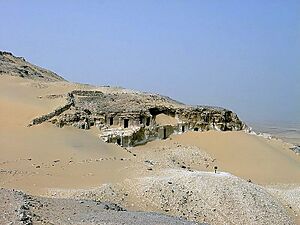Meir, Egypt facts for kids
Quick facts for kids
Meir
|
|
|---|---|
| Country | |
| Governorate | Asyut |
| Time zone | UTC+2 (EST) |
| • Summer (DST) | +3 |
The necropolis of Meir is an ancient burial ground in Middle Egypt. A necropolis is like a large cemetery. It is located on the west bank of the Nile River in the Asyut Governorate. This site holds the graves of important people from the ancient Egyptian Old and Middle Kingdom. These people included local governors called nomarchs, mayors, and priests from the nearby city of Cusae.
The cemetery gets its name from the village of Meir. This village is about 5 kilometers (3 miles) northeast of the burial site. It is also about 7 kilometers (4 miles) southwest of el-Qusiya, which was the ancient city of Cusae.
Contents
Exploring the Ancient Tombs of Meir
Meir served as the main cemetery for the ancient city of Cusae. This city was located in Egypt, north of Asyut. The cemetery was used during the Old Kingdom and Middle Kingdom. This period covers the 6th through 12th Dynasties of ancient Egypt. It was the burial place for the nomarchs, who were like governors, of the fourteenth region of Upper Egypt.
Below the hillside where the important rock-cut tombs are, there is another cemetery. This area was for the more common people of the city. The rock-cut tombs were only for the nomarchs of Cusae. Cusae was a special religious center for the Egyptian goddess Hathor. Evidence of Hathor worship was found in the tombs. Inscriptions on the walls mention Hathor's priestesses. There are also many pictures of cows, which were sacred to Hathor.
Aylward Blackman was the main archaeologist who excavated this site. He published six books about his discoveries. The tombs are arranged from North to South along a hillside. Blackman labeled the main tomb-chapels A through E. Meir is known for having some of the best-preserved Middle Kingdom tombs. These tombs are famous for their very detailed carvings. These carvings show scenes from daily life in ancient Egypt. Important tombs found here include those of Ukh-Hotep and Pepyankh the Middle.
Early Discoveries at Meir
Before archaeologists began their work, many tombs at Meir were damaged. Some were robbed for their wood. Later, incomplete tomb pieces were even burned. They were thought to be worthless and in the way.
In 1890, archaeologist Émile Gaston Chassinat visited Meir. His visit made other archaeologists interested in the site. Soon after, several archaeologists explored Meir. These included Georges Émile Jules Daressy (1900), Alessandro Barsanti, Georges Legrain (1900), Jean Clédat (1901–1902), and Sha’ban (1903). Their reports mostly focused on the largest tombs. However, these reports often lacked many details.
Finally, from 1912 to 1950, Aylward Blackman spent a long time excavating Meir. He published six books describing the various rock-cut tombs. Blackman mainly focused on the more complete and fancy tombs. This meant that less grand tombs remained unexplored. Ahmed Bey Kamal then took over the excavation from 1910 to 1914. He worked to explore the less famous or incomplete tombs.
Tombs of the Nomarchs
The tombs at Meir date from the 6th to the 12th Dynasty. They were important burial places for the rulers of the fourteenth region. When Aylward Blackman excavated them, he gave them letters A through E. This helped to identify the different rock-cut tombs. These tombs were carved into a hillside. They were laid out in a line from North to South.
There are about seventy-five tombs at this site with decorated interiors. Many others have been robbed or damaged over the years. Below the main rock-cut tombs, there is a cemetery for common people. Not much excavation has been done on this "commoner" cemetery. There is little information about it in the books by the main excavators of Meir.
The Tomb of Ukhhotep II (B2)
The Tomb of Pepyankh the Middle
The tomb of Pepyankh the Middle (D2) is also known as Heny the Middle. It dates back to the time of Pepi II. Blackman published his findings on this tomb in 1924. His book was titled The Rock Tombs of Meir Vol. IV: The Tomb-Chapel of Pepi’onkh the Middle son of Sebkhotpe and Pekhernefert. Later, in 2012, Naguib Kanawati published another book. It was called The Cemetery of Meir: Vol. 1 The tomb of Pepyankh the Middle.
When the tomb was excavated, archaeologists learned about Pepyankh the Middle. He was the son of Sebkhotpe (Hepi) and Pepkhernefert (Bebi). His wife was Hewetiaah. Pepyankh the Middle and Hewetiaah had six sons and three daughters. The tomb also showed the many important titles Pepyankh the Middle held. These included 'Confidant of the King in his Every Place'. He was also 'Overseer of Upper Egypt in Reality' and a 'Hereditary Prince'. He was also the 'Superintendent of the Priests of Hathor'.
This tomb was found undisturbed by Ahmed Bey Kamal's workers in March 1913. It was the largest tomb found at the Meir cemetery. Like other tombs at Meir, Pepyankh the Middle's tomb has beautiful carvings. These carvings show scenes from daily life. One description says the walls of a room were covered with painted carvings. Their bright colors stood out against a dark background. Even though the technique was sometimes simple, the details are amazing.
Religious Beliefs at Meir
In all the decorated tombs at Meir, it is clear that the goddess Hathor was very important. She played a big role in the lives of the people of Cusae. Blackman's books show that almost all the nomarchs and their families had roles connected to Hathor. Many nomarchs held titles like 'Overseer of prophets of Hathor' or 'Priest of Hathor'. Many important women had the title 'Priestess of Hathor'.
Besides these titles, there are also carvings of ceremonies related to Hathor. These are found on the tomb walls. For example, in the tomb of Senbi's son Ukh-hotp, there is a carving. It shows a ceremonial fight between two bulls. It is believed this fight was to win the honor of being with Hathor, who was seen as a cow goddess.
Key Tombs (A–E)
Here are some of the important tombs found at Meir, labeled by Blackman:
- A1. Ni’ankh-Pepy-kem (Sebkhotp/Hepi-kem) (During Pepi I): A high official who oversaw Upper Egypt and prophets.
- A2. Pepy-ankh the youngest (Heni-kem) (During Pepi II): Overseer of the duckpool and prophets; son of Ni’ankh-Pepy-kem.
- A3. Ukhhotep (During Senusret I): A nomarch and overseer of sealers; son of Iam.
- A4. Hepi-kem (During Merenre Nemtyemsaf II): Another high official for Upper Egypt and prophets.
- B1. Senbi (During Amenemhat I): A nomarch and overseer of prophets; son of Ukh-hotp.
- B2. Ukhhotep II (During Senusret I): Nomarch of the Atef-nome and overseer of Hathor's prophets; son of Senbi (B1).
- B3. Senbi (During Senusret I): A hereditary prince and overseer of prophets; son of Ukh-hotp (B2).
- B4. Ukhhotep (During Amenemhat II): A nomarch and overseer of Hathor's prophets; son of Ukhhotep (A3) and Mersi.
- C1. Ukhhotep (During Senusret II): A nomarch and overseer of prophets; son of Ukhhotep and Heny the middle.
- C2. Kha’kheperre-sonb (Iy) (During Senusret II): A nomarch and overseer of prophets.
- D1. Pepi: A royal scribe and judge.
- D2. Pepy-‘ankh-hir-ib (Neferka/Heny/Pepyankh the Middle) (During Pepi II): A nomarch, vizier, and overseer of Hathor's prophets.
- E1. Meni (Menia): An inspector of prophets and close to the king.
- E2. Nenki: An intimate and lector (a reader of sacred texts).
- E3. Pepy-‘ankh (During Pepi II): An intimate and lector.
- E4. Thetu: Overseer of Thentet-cows and an inspector of prophets.




